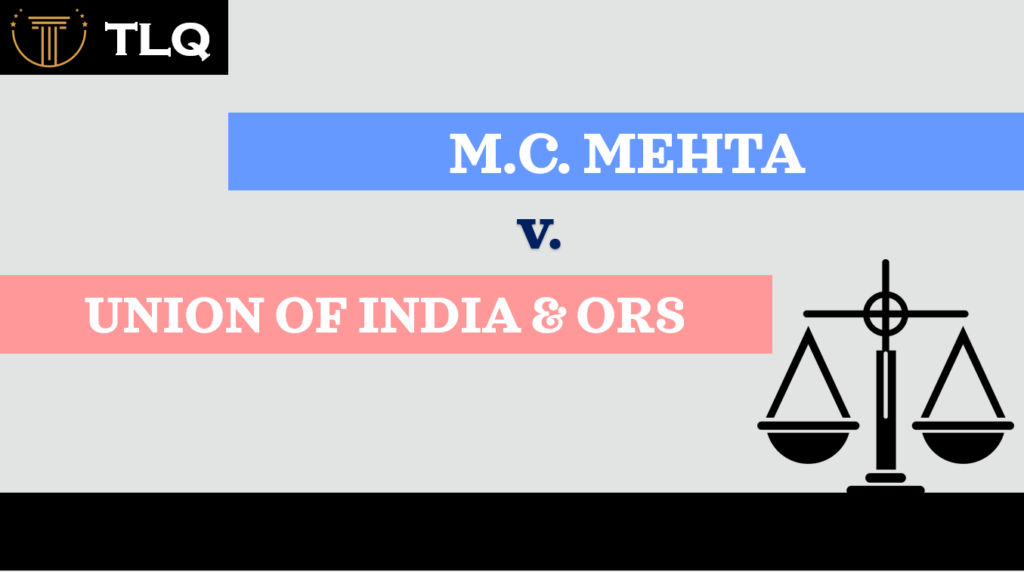Published On: 20th April, 2024

NAME OF THE CASE – M.C.MEHTA VS UNION OF INDIA & ORS (TAJ TRAPEZIUM CASE)
COURT – SUPREME COURT OF INDIA
DATE OF JUDGMENT – 30-12-1996
CITATION – AIR 1997 2 SCC 353
INTRODUCTION
The Taj Mahal, an ivory-white marble mausoleum, a monument of international repute, and one of the Seven Wonders of the World is renowned for its exquisite architecture. It stands out as one of the most priceless national monument and a glorious tribute to the field of Architecture and Engineering. It was built by Mughal emperor Shahjahan in the loving memory of his wife Mumtaz. The 10,400 sq km trapezium-shaped region around the Taj Mahal is known as the Taj Trapezium Zone (hereinafter referred to as ‘TTZ’) covering five districts within the Agra region of Uttar Pradesh State in India. The Agra Fort, Taj Mahal, and Fatehpur Sikri are all parts of the UNESCO World Heritage sites in Agra. Ironically, The Taj was threatened with deterioration and degradation not only due to traditional causes of decay but also due to atmospheric pollution. An American Express Company named as World Monuments Fund in 1996 published a list of 100 most endangered sites in which the name of ‘Taj Mahal’ was also included.
Mr. M.C. Mehta, an environmentalist, and public interest attorney, who visited The Taj Mahal in 1984 and noticed that the white marble of the Taj Mahal turning yellow. To bring this matter into the lime light, he filed a public interest litigation before the Supreme Court drawing the attention of the Court towards the degradation of the Taj Mahal due to the atmospheric pollution and requested issue appropriate directions to the authorities concerned to take immediate steps to stop air pollution in the Taj Trapezium Zone and to save the Taj Mahal.
FACTS
- The Taj Mahal case, also known as The Taj Trapezium Case (TTZ) was fought between renowned environmentalists and a public interest attorney M.C. Mehta and the Union of India & Ors in 1985. He is also known as the ‘Green Lawyer of India’ who single-handedly fought against the polluting industries in India.
- M.C. Mehta Taj Mahal case involves a series of legal proceedings aimed at protecting the iconic Taj Mahal from environmental degradation.
- The white marble of the Taj Mahal turned into yellow color mostly due to pollution and acid rain because of the presence of pollutants, like sulphar dioxide combined with oxygen and moisture, creating a corrosive effect in the atmosphere. The decay is more apparent inside the Taj. The declining state of the monument led to the submission of the petition. The rising pollution became a serious issue to protect the Taj Mahal from degradation. Therefore, the request was raised for the protection of the Taj Mahal.
ISSUES
- Whether the Taj Trapezium Zone being significantly harmed by pollution affecting Taj Mahal and its surroundings?
- Whether or not usages of coke/coal as an industrial fuel by the industry located in TTZ is the cause of deteriorating conditions of Taj Mahal and the residents of that area?
- Whether Government Authorities were taking adequate measures to control pollution and protect this iconic monument?
- What legal actions should be taken to mitigate pollution and ensure the long term preservation of the Taj Mahal?
Arguments from the plaintiff’s side
- From the plaintiff’s side M. C. Mehta argued that the hazardous chemical industries, brick factories, rubber and lime processing units, iron foundries etc. which are functioning around the Taj Mahal were the major sources of damage caused to the monument. The Mathura refinery and Firozabad Glass Industry were the distant sources which also contributed to the same as stated in the report of the Central Pollution Control Board. So a detailed survey was necessary over the region to find out the actual industries which were causing irresistible damage.
- M.C. Mehta’s argument also revolved around the adverse impact of acidic emissions from the industries which had posed significant threats to our ecosystem affecting plants and architectural materials like marble and red stone.
- Apart from that, regarding the pipeline proposal, M.C. Mehta suggested an alternative route from Auria or Babrala to Mathura citing economic and time saving benefits instead of laying the pipeline from Bijapur to Dadri via Mathura. He further submitted that if the pipeline is drawn from Auria, it would also serve the industries situated at Firozabad and Agra.
In this case the Supreme Court examined several reports presented by different Authorities which are as follows-
- Central Board for the Prevention and Control of Water Pollution Report
The report identified various industrial activities in Agra and estimated sulphar dioxide contribution from different sources, emphasizing the impact on air quality around the Taj Mahal.
- U.P. Pollution Control Board Action
Pursuant to the court orders, the U.P. Pollution Control Board by submitting affidavits categorized industries in the Agra region, highlighting the prevalence of polluting industries and the non-compliance by the various industries leading to closures until pollution control devices were installed.
- NEERI Report and Recommendations
- The National Environmental Engineering Research Institute examined the decay mechanism of Taj Mahal’s marble due to pollutants, particularly sulphar dioxide and submitted a report in October 1993 focusing on sulphar dioxide emission control measures at the Mathura Refinery.
- The report emphasized strategies like the use of natural gas, specific refinery units, and the creation of a green belt around the refinery to mitigate pollution effects.
- Supreme Court’s examination and Government Actions
- The Court in April 1994 acknowledged NEERI’s findings affirming that industries in the Taj Trapezium Zone were the primary sources of pollution affecting the Taj Mahal.
- The court endorsed NEERI’S recommendations including the potential relocation of polluting industries outside the TTZ and the implementation of a Green Belt development Plan around the Taj. The Court directed the initiation of the Green Belt Project.
- The Government in May 1994 appointed The Varadharajan committee to address environmental concerns.
- Varadharajan Committee recommendations
- The Varadharajan committee expressed concern about pollution levels in Agra and recommended the creation of an authority to monitor emissions and air quality continuously.
- The committee recommended preventing new industries from causing pollution northwest of the Taj Mahal.
- The report clearly showed that the level of Suspended Particulate Matter (SPM) in the Taj Mahal area is high and concluded that the sources of pollution in Agra region were all Coal users. It proposed relocating small and large industries to avoid emissions towards the monument.
Arguments from the Defendants’ side
- Learned Senior Counsel Mr. Venugopal appeared for the Uttar Pradesh State Industrial Development Corporation (UPSIDC) and stated that the said UPSIDC would examine the demand of each of the industries and relocate the requisite area outside the TTZ for shifting the industries.
- Kapil Sibal and Mr. Sanjay Parekh, Learned Counsel for most of the industries informed the court that the industries are taking steps to approach the GAIL (Gas Authority of India Limited) for Gas connection. This is a matter between the industries and GAIL.
Finally, Mr. Kapil Sibal and Mr. Sanjay Parekh clearly stated that all industries would accept Gas as an industrial fuel. The whole purpose is to stop air pollution by banishing coal from TTZ.
Holding
There were four NEERI REPORTS, two Varadharajan Reports, and several others Reports by the Board which were placed on record before the Hon’ble Court. NEERI and Varadharajan Reports had specifically recommended the relocation of industries from the TTZ.
After examining all the reports and taking into consideration other materials on the record, the Supreme Court held that the industries in the TTZ were active contributors to the air pollution in the said area.
Reasoning
Environmental Law Principles applied in Taj Trapezium Case
- Sustainable Development–
The concept of sustainable development was brought at Cocoyox Declaration in 1972 for the first time and received proper support at the Stockholm Conference. It ensures a harmonious balance between development and protection of the environment.
- Precautionary Principle–
The Precautionary principle plays a huge role with respect to the burden of proof. The principles of precaution involve anticipation of environmental harm and taking measures to avoid it or to choose the least environmentally harmful activity.
- Polluter Pays principle–
Polluter Pays Principle is applied after the environmental degradation has taken place. This Principle creates absolute liability on the polluter.
- Article 21 of the Indian Constitution which guarantees protection of life and personal liberty.
- Article 47 recognizes the duty of state to raise the level of nutrition and standard of living and to improve public health.
- Article 48 A envisages that the State shall endeavor to protect and improve the environment and to safeguard the forests and wildlife of the Country.
- Article 51 A (g)- It deals with fundamental duties of the citizen. As well as having compassion for all living things, it is the responsibility of every person to preserve and enhance the natural environment, which includes forests, lakes, rivers, and wildlife.
JUDGMENT
The Supreme Court recognizes the environmental threat to the Taj Mahal’s exotic beauty and cultural significance and finally delivered the Judgment on 30th December 1996 by a Division Bench comprising of Justice Kuldip Singh and Justice Faizan Uddin. Main important elements of this Judgment are as follows:
- The Judgment covers only 292 polluting industries (out of 510 industries) locally operating in the area were the main source of pollution and directed them to change over within fixed time schedule to natural gas as industrial fuel and if they could not do so they must stop functioning beyond 31st December, 1997.
- Supreme Court directed the industries operating in Taj Trapezium Zone (TTZ), using coal, coke as industrial fuel must stop functioning in and around Agra and they should be relocated alternative plots in the industrial estate outside TTZ and directed the Uttar Pradesh Government to render all assistance to the industries in the process of relocation.
- The Apex Court also directed that the employees and workers affected by such shifting of industries or their closure was not thrown out of employment and not totally deprived of their right to livelihood and a ‘shifting Bonus’ would be provided for their relocation. However, Workmen refusing to relocate would be retrenched. They would be provided with compensation as per sec 25 F-(b) of Industrial Disputes Act along with gratuity amount in addition.
- The Apex Court has instructed the Central Govt. to prepare a comprehensive plan to protect the Taj Mahal and its environment. The Judgment emphasizes the need for multiple prolonged approaches involving environmental conservation to management and pollution control to safeguard the Taj Mahal.
- The main focus of the Judgment is to maintain the balance of protecting the interest of industries and its workers along with the conservation of ecology and environment of Taj Trapezium Zone by applying the Principle of sustainable development, Precautionary Principle and Polluter Pays Principle.
CONCLUSION
Pollution is rising rapidly all over the world. This case helped to recognize the environmental damage around the Historic monuments. It created awareness to take the initiative to prevent the damage and taking requisite measures against the environmental degradation as well. Apart from the Constitutional provisions mentioned above, the Apex Court also relied upon several statutory enactments as well which are part of the environmental law of the land.
This Landmark Judgment espoused the cause of Great Awakening for protection of the national heritages from deterioration and damage due to the environmental pollution. The Apex Court took a remarkable initiative by giving due consideration to various principle and concepts of environmental law.





